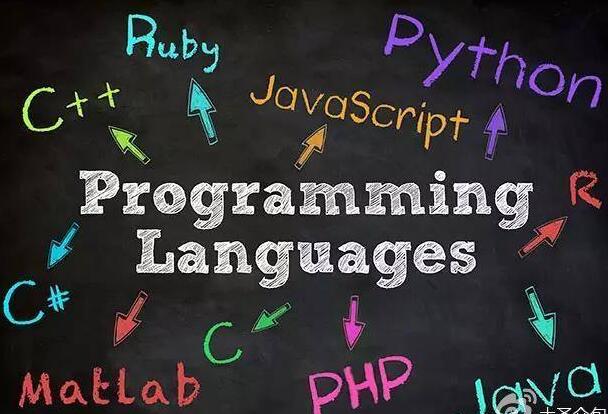社交网站后端项目开发日记(一)
本项目目标是开发一个社区网站,拥有发帖、讨论、搜索、登录等一个正常社区拥有的功能。涉及到的版本参数为:
- JDK1.8
- Maven3.8.1(直接集成到IDEA)
- Springboot 2.5.1
- tomcat
参考网站(在使用框架过程中可能会看的开发文档):
https://mvnrepository.com/ 查找maven依赖
https://mybatis.org/mybatis-3/zh/index.html mybatis的官方文档,配置等都有说明
项目代码已发布到github https://github.com/GaoYuan-1/web-project
关于数据库文件,该篇博客中已有提到,可去文中github获取数据 MySQL基础篇(一)
本文第一篇只介绍了基础,在(二)中将会介绍如何实现登录界面等后续内容。最终将会把完整项目经历发布出来。
本系列主要介绍的是实战内容,对于理论知识介绍较少,适合有一定基础的人。
首先创建一个项目,可利用Spring Initializr
本人配置如下:

maven项目的
pom.xml中初始依赖如下,后面会增加更多依赖。
<dependencies>
<dependency>
<groupId>org.springframework.boot</groupId>
<artifactId>spring-boot-starter-aop</artifactId>
</dependency>
<dependency>
<groupId>org.springframework.boot</groupId>
<artifactId>spring-boot-starter-thymeleaf</artifactId>
</dependency>
<dependency>
<groupId>org.springframework.boot</groupId>
<artifactId>spring-boot-starter-web</artifactId>
</dependency>
<dependency>
<groupId>org.springframework.boot</groupId>
<artifactId>spring-boot-devtools</artifactId>
<scope>runtime</scope>
<optional>true</optional>
</dependency>
<dependency>
<groupId>org.springframework.boot</groupId>
<artifactId>spring-boot-starter-test</artifactId>
<scope>test</scope>
</dependency>
</dependencies>
1. Spring相关知识
记录一些基本概念,Spring的知识可能说的比较少,本篇关注于如何对网站进行实现。
Spring Bean是被实例的,组装的及被Spring 容器管理的Java对象。
Spring 容器会自动完成@bean对象的实例化。
创建应用对象之间的协作关系的行为称为:装配(wiring),这就是依赖注入的本质。
在使用 Spring Initializr 之后,第一个接触的注解为:
@SpringBootApplication
我们可以把 @SpringBootApplication 看作是 @Configuration、@EnableAutoConfiguration、@ComponentScan 注解的集合。
根据 SpringBoot 官网,这三个注解的作用分别是:
@EnableAutoConfiguration:启用 SpringBoot 的自动配置机制@ComponentScan: 扫描被@Component (@Service,@Controller)注解的 bean,注解默认会扫描该类所在的包下所有的类。@Configuration:允许在 Spring 上下文中注册额外的 bean 或导入其他配置类(表示该类是配置类)
Spring通过识别一些注解可以让容器自动装填bean:
- @Component :通用的注解,可标注任意类为 Spring 组件。如果一个 Bean 不知道属于哪个层,可以使用@Component 注解标注。
- @Repository : 对应持久层即 Dao 层,主要用于数据库相关操作。
- @Service : 对应服务层,主要涉及一些复杂的逻辑,需要用到 Dao (Data Access Object)层。
- @Controller : 对应 Spring MVC 控制层,主要用户接受用户请求并调用 Service 层返回数据给前端页面。
关于@Scope,负责声明Bean的作用域:
@Scope("singleton") //唯一 bean 实例,Spring 中的 bean 默认都是单例的。
@Scope("prototype") //每次请求都会创建一个新的 bean 实例。
@Scope("request") //每一次 HTTP 请求都会产生一个新的 bean,该 bean 仅在当前 HTTP request 内有效。
@Scope("session") //每一次 HTTP 请求都会产生一个新的 bean,该 bean 仅在当前 HTTP session 内有效。
关于@Autowired:
自动导入对象到类中,被注入进的类同样要被 Spring 容器管理。从构造器,到方法,到参数、属性、注解,都可以加上@Autowired注解。
2. SpringMVC相关
可以先了解一些HTTP流的相关知识:(参考自MDN Web Docs)
当客户端想要和服务端进行信息交互时(服务端是指最终服务器,或者是一个中间代理),过程表现为下面几步:
-
打开一个TCP连接:TCP连接被用来发送一条或多条请求,以及接受响应消息。客户端可能打开一条新的连接,或重用一个已经存在的连接,或者也可能开几个新的TCP连接连向服务端。
-
发送一个HTTP报文:HTTP报文(在HTTP/2之前)是语义可读的。在HTTP/2中,这些简单的消息被封装在了帧中,这使得报文不能被直接读取,但是原理仍是相同的。
GET / HTTP/1.1 Host: developer.mozilla.org Accept-Language: fr -
读取服务端返回的报文信息:
HTTP/1.1 200 OK Date: Sat, 09 Oct 2010 14:28:02 GMT Server: Apache Last-Modified: Tue, 01 Dec 2009 20:18:22 GMT ETag: "51142bc1-7449-479b075b2891b" Accept-Ranges: bytes Content-Length: 29769 Content-Type: text/html <!DOCTYPE html... (here comes the 29769 bytes of the requested web page) -
关闭连接或者为后续请求重用连接。
当HTTP流水线启动时,后续请求都可以不用等待第一个请求的成功响应就被发送。然而HTTP流水线已被证明很难在现有的网络中实现,因为现有网络中有很多老旧的软件与现代版本的软件共存。因此,HTTP流水线已被在有多请求下表现得更稳健的HTTP/2的帧所取代。
HTTP请求的例子:
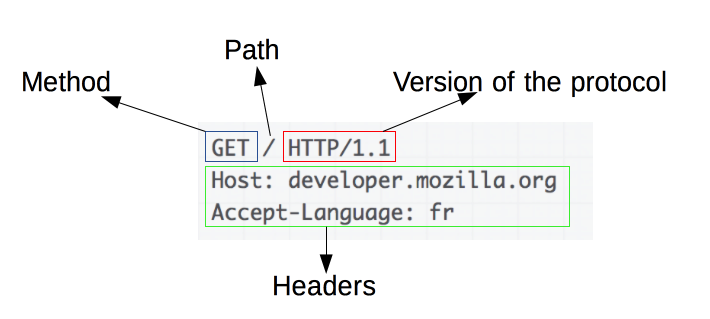
响应的例子:

2.1 SpringMVC概要
三层架构:表现层,业务层和数据访问层。
MVC:Model(模型层),View(视图层),Controller(控制层)
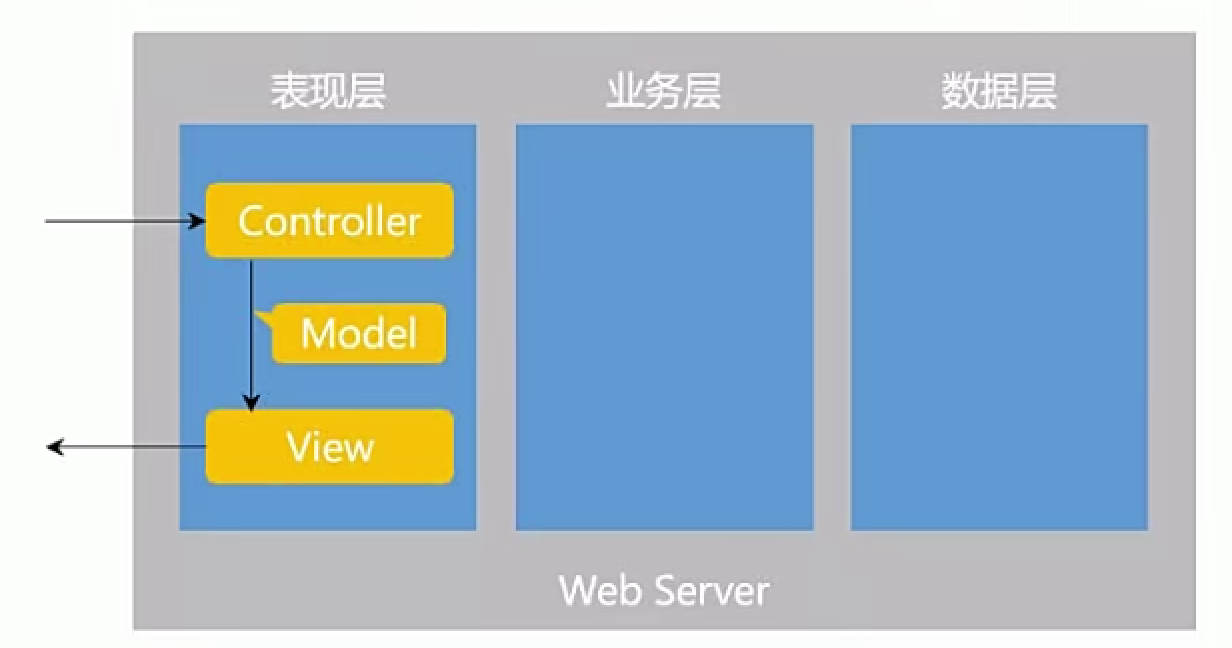
核心组件: DispatcherServlet
2.2 Thymeleaf思想
如果想给浏览器返回一个动态网页,则需要一个工具支持,例如:Thymeleaf(模板引擎,生成动态的HTML)。

该引擎需要学习的有:标准表达式,判断与循环,模板的布局。
学习建议参考官方文档 https://www.thymeleaf.org/index.html
2.3 SpringMVC代码示例
GET请求
@RequestMapping支持Servlet的request和response作为参数,以下为一个简单示例:
@Controller
@RequestMapping("/alpha")
public class AlphaController {
@RequestMapping("/hello")
@ResponseBody
public String sayHello(){
return "Hello Spring Boot.";
}
@RequestMapping("/http")
public void http(HttpServletRequest request, HttpServletResponse response) throws IOException {
//获取请求数据
System.out.println(request.getMethod());
System.out.println(request.getServletPath());//请求路径
Enumeration<String> enumeration = request.getHeaderNames();//得到请求行的key
while(enumeration.hasMoreElements()) {
String name = enumeration.nextElement(); //当前值(key)
String value = request.getHeader(name);//得到value
System.out.println(name + ":" + value);
}
System.out.println(request.getParameter("code"));
// 返回响应数据
response.setContentType("text/html;charset=utf-8");//返回网页类型的文本
PrintWriter writer = response.getWriter();
writer.write("<h1>牛客网</h1>");//这里只进行简单输出
writer.close();
}
}
在项目Controller层加入代码,以response体返回一个html的文本。
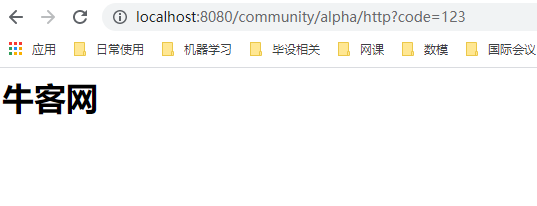
这是通过底层对象处理请求的方式,便于理解。
更简单的方式为:
// GET请求,用于获取某些数据
// /students?current=1&limit=20 假设查询学生数据,第一页,每页20条
@RequestMapping(path = "/students", method = RequestMethod.GET)
@ResponseBody
// public String getStudents(int current,int limit) { //直接使用Int类型,前端控制器会自动识别匹配
// System.out.println(current);
// System.out.println(limit);
// return "some students";
// }
// 也可加上注解
public String getStudents(
@RequestParam(name = "current", required = false, defaultValue = "1") int current,
@RequestParam(name = "limit", required = false, defaultValue = "1") int limit) {
System.out.println(current);
System.out.println(limit);
return "some students";
}
利用@ResponseBody注解,实现效果为:

控制台返回结果:
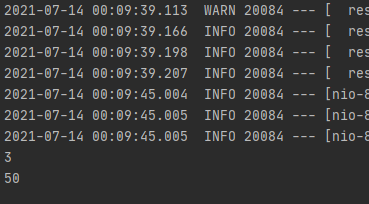
利用这种方式,不论是返回数据还是获取数据都很方便。
另外,通过路径方式传参查询的话:(注意,路径长度并不是无限的,并不可以传很多参数)
// /student/123 查询某个学生,直接放在路径中
@RequestMapping(path = "/student/{id}", method = RequestMethod.GET)
@ResponseBody
public String getStudent(@PathVariable("id") int id) {
System.out.println(id);
return "a student";
}
注意以上传参时使用的两个注解。
POST请求
如何向浏览器提交数据?
在项目静态文件中添加html文件,action指示路径
<!DOCTYPE html>
<html lang="en">
<head>
<meta charset="UTF-8">
<title>增加学生</title>
</head>
<body>
<form method="post" action="/community/alpha/student">
<p>
姓名:<input type="text" name="name">
</p>
<p>
年龄:<input type="text" name="age">
</p>
<p>
<input type="submit" value="保存">
</p>
</form>
</body>
</html>
//POST请求
@RequestMapping(path = "/student", method = RequestMethod.POST)
@ResponseBody
public String saveStudent(String name, int age) {
System.out.println(name);
System.out.println(age);
return "success";
}
在Controller中代码如下,展示效果:
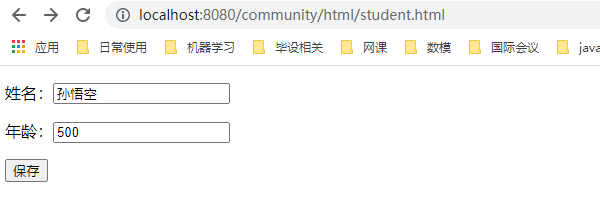
控制台:

响应HTML数据
从程序内部响应到HTML
//响应HTML数据
@RequestMapping(path = "/teacher", method = RequestMethod.GET)
public ModelAndView getTeacher() { //这个对象就是向前端控制器返回的moder和view
ModelAndView mav = new ModelAndView();
mav.addObject("name", "张三");
mav.addObject("age", 30);
mav.setViewName("/demo/view");//这个view实际上指的是view.html
return mav;
}
Controller代码
此外,还需要一个动态网页,利用thymeleaf模板引擎(resource/templates)。
<!DOCTYPE html>
<html lang="en" xmlns:th="http://www.thymeleaf.org"> <!--声明这不是html文件,而是一个thymeleaf模板-->
<head>
<meta charset="UTF-8">
<title>Teacher</title>
</head>
<body>
<p th:text="${name}"></p>
<p th:text="${age}"></p>
</body>
</html>
实现效果,程序已经设定初始值。

模板引擎会自动进行处理。
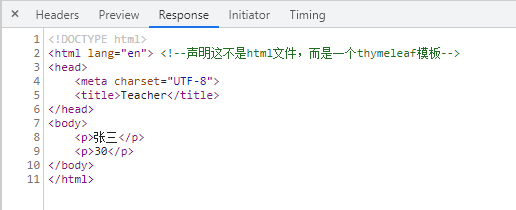
另一种方式:
@RequestMapping(path = "/school", method = RequestMethod.GET)
public String getSchool(Model model) { //前端控制器会创建一个model
model.addAttribute("name","大学");
model.addAttribute("age",80);
return "/demo/view"; //这里return的是view的路径
}
这两种方式是model和view的对象使用方式不同。效果还是一致的,第二种要更加简便一些。

响应JSON数据
异步请求可以理解为:当前网页不刷新,但是进行了数据交互,比如注册账号时,经常会检测用户名是否重复,这时候网页并没有刷新,但是访问了数据库进行查询。
//响应JSON数据(异步请求)
// Java对象传给浏览器:需要转为JS对象,这时候就可以通过JSON进行转化
// Java对象-> JSON字符串 -> JS对象等等
@RequestMapping(path = "/emp", method = RequestMethod.GET)
@ResponseBody
public Map<String,Object> getEmp() { //自动会将map转为JSON字符串
Map<String,Object> emp = new HashMap<>();
emp.put("name","张三");
emp.put("age",23);
emp.put("salary",8000.00);
return emp;
}
注意,这里并没有返回html。
这里只是简单介绍了响应方式,以后的博客中会介绍具体应用及代码。

3. MyBatis
MyBatis 是一款优秀的持久层框架,它支持自定义 SQL、存储过程以及高级映射。MyBatis 免除了几乎所有的 JDBC 代码以及设置参数和获取结果集的工作。MyBatis 可以通过简单的 XML 或注解来配置和映射原始类型、接口和 Java POJO(Plain Old Java Objects,普通老式 Java 对象)为数据库中的记录。

mybatis文档
mybatis-spring文档
在maven项目pom.xml中添加依赖
<dependency>
<groupId>mysql</groupId>
<artifactId>mysql-connector-java</artifactId>
<version>8.0.25</version>
</dependency>
<dependency>
<groupId>org.mybatis.spring.boot</groupId>
<artifactId>mybatis-spring-boot-starter</artifactId>
<version>2.2.0</version>
</dependency>
在SpringBoot框架下,只需要对application.properties进行配置,增加如下:
# DataSourceProperties
spring.datasource.driver-class-name=com.mysql.cj.jdbc.Driver
spring.datasource.url=jdbc:mysql://localhost:3306/community?characterEncoding=utf-8&useSSL=false&serverTimezone=Hongkong
spring.datasource.username=root
spring.datasource.password=Ss6215615
#设置连接池,这个比较好
spring.datasource.type=com.zaxxer.hikari.HikariDataSource
spring.datasource.hikari.maximum-pool-size=15
spring.datasource.hikari.minimum-idle=5
spring.datasource.hikari.idle-timeout=30000
# MybatisProperties
mybatis.mapper-locations=classpath:mapper/*.xml
mybatis.type-aliases-package=com.nowcoder.community.entity
mybatis.configuration.useGeneratedKeys=true
#自动匹配 a_b == aB
mybatis.configuration.mapUnderscoreToCamelCase=true
# logger,设置日志,方便在控制台查看信息
logging.level.com.nowcoder.community=debug
mybatis.type-aliases-package=com.nowcoder.community.entity
这行代码声明了SQL中记录在Java中的对象位置,根据SQL中的属性建立对象。
public class User {
private int id;
private String username;
private String password;
private String salt;
private String email;
private int type;
private int status;
private String activationCode;
private String headerUrl;
private Date createTime;
//等等,还有set,get,toString
建立对象之后,在项目中的dao文件,建立UserMapper(对于User的操作)接口,Mybatis只需要通过xml文件对操作进行声明。
<?xml version="1.0" encoding="UTF-8" ?>
<!DOCTYPE mapper
PUBLIC "-//mybatis.org//DTD Mapper 3.0//EN"
"http://mybatis.org/dtd/mybatis-3-mapper.dtd">
<mapper namespace="com.nowcoder.community.dao.UserMapper"> <!-- 这里写UserMapper的全限定名 -->
<sql id="selectFields">
id, username, password, salt, email, type, status, activation_code, header_url, create_time
</sql>
<sql id="insertFields">
username, password, salt, email, type, status, activation_code, header_url, create_time
</sql>
<select id="selectById" resultType="User"> <!-- 配置里进行过设置package,否则需要写全限定名 -->
select <include refid="selectFields"></include>
from user
where id = #{id} <!-- 这里的意思是要引用方法的参数 -->
</select>
<select id="selectByName" resultType="User"> <!-- 配置里进行过设置package,否则需要写全限定名 -->
select <include refid="selectFields"></include>
from user
where username = #{username} <!-- 这里的意思是要引用方法的参数 -->
</select>
<select id="selectByEmail" resultType="User"> <!-- 配置里进行过设置package,否则需要写全限定名 -->
select id, username, password, salt, email, type, status, activation_code, header_url, create_time
from user
where email = #{email} <!-- 这里的意思是要引用方法的参数 -->
</select>
<insert id="insertUser" parameterType="User" keyProperty="id">
insert into user (<include refid="insertFields"></include>)
values(#{username}, #{password}, #{salt}, #{email}, #{type}, #{status}, #{activationCode}, #{headerUrl}, #{createTime})
</insert>
<update id="updateStatus">
update user set status = #{status} where id = #{id}
</update>
<update id="updateHeader">
update user set header_url = #{headerUrl} where id = #{id}
</update>
<update id="updatePassword">
update user set password = #{password} where id = #{id}
</update>
</mapper>
这里建立了增删改的操作。
mybatis.mapper-locations=classpath:mapper/*.xml
根据已有的配置在resource文件夹中建立mapper目录和.xml文件。
由于.xml文件不会自动检测编译,建议在test中依次测试相应功能,以免出现错误。
4. 总结
本项目计划使用SpringBoot框架进行一个社交网站的开发,首先使用Spring Initializr对maven项目进行建立,之后对Spring的基本概念进行了一定阐述,IOC和AOP均没有讲到,将会在后续开放的Spring学习篇中,对SpringMVC的基本使用(GET,POST请求和响应数据)进行了代码示范,方便理解后续代码。另外,介绍了Mybatis的使用,以及公布了部分示范代码。
上手起来是非常快的,本系列的目的在于,重点讲解实战部分,理论部分将在其他博客中展开。
下篇博客将会对网站的登陆界面等如何实现进行阐述。

